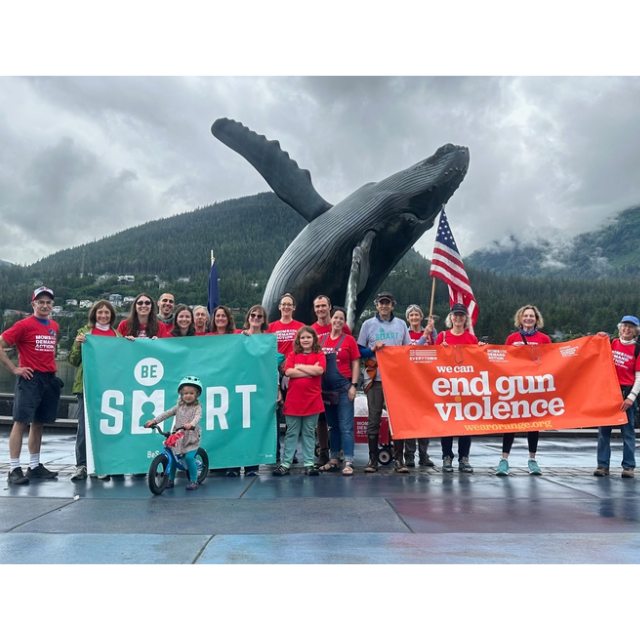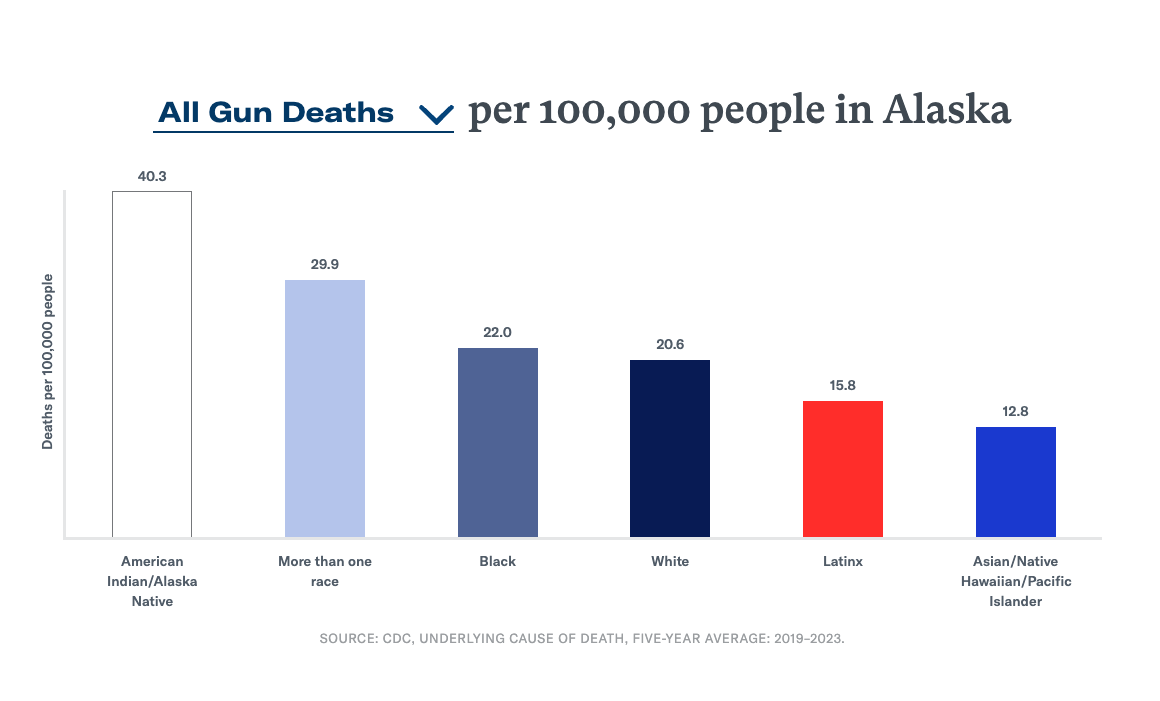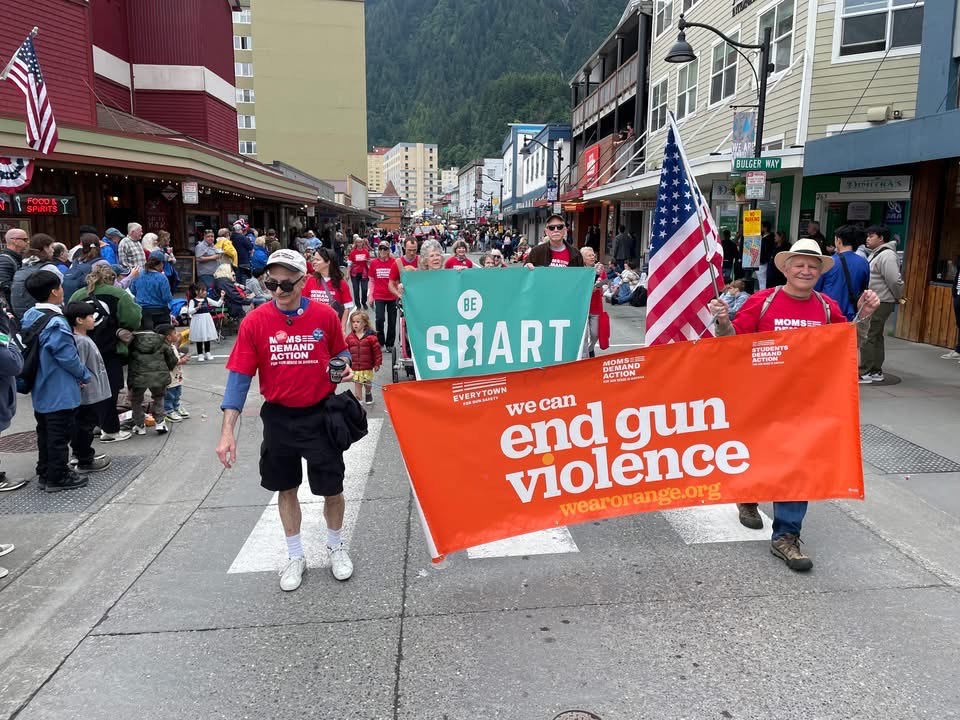Spreading the Be SMART Message in Alaska: ‘If We Can Prevent Even One Child Death, Then It Is Our Responsibility to Do So’

9.8.2025
In recent decades, the most common reason nationally for owning a gun has shifted from hunting or recreation to protection or self-defense. For gun owners in America’s last frontier, those reasons often go hand in hand.
Gun ownership in Alaska is deeply intertwined with family, tradition, and a sense of protection. Many families fill their freezers with meat they have hunted, and rural communities rely on subsistence hunting to sustain them through long winters. Some children and teens help their families hunt and take pride in using traditional methods to put food on the table. Wildlife encounters are not infrequent aspects of daily life. For rural and even urban Alaskans who want more than bear spray for protection, the question “What if I need quick access to my gun to defend myself from a bear or moose?” may not be hypothetical. And access to a gun in those moments, although a last resort, can be the difference between life and death.
In Alaska, “rural” often means that a community can only be accessed by small planes, by boat or Alaska’s ferry system, or by vehicles or snowmachines after rivers and lakes freeze in the winter. Importing food and goods also comes with a high price tag. Because of this cost, some families in Alaska harvest their own food and hunt for subsistence, a tradition they pass along to their children.
When members of the Alaska Moms Demand Action chapter volunteer at community events for Be SMART, a program of the Everytown for Gun Safety Support Fund, the reception is generally positive. Because access to a gun triples the risk of death by suicide,1Andrew Anglemyer, Tara Horvath, and George Rutherford, “The Accessibility of Firearms and Risk for Suicide and Homicide Victimization Among Household Members: A Systematic Review and Meta-Analysis,” Annals of Internal Medicine 160, no. 2 (2014): 101–10, https://doi.org/10.7326/M13-1301.
and Alaska ranks among states with the highest levels of household firearm ownership, much of the chapter’s Be SMART efforts emphasize the importance of suicide prevention.
Many chapter members are gun owners themselves, so they know how to reach the person on the other side of the table when they are talking about secure firearm storage. If a person asks how they can quickly defend themselves from an aggressive animal on their property, Be SMART volunteers answer that securing weapons with a biometric safe or trigger lock can provide fast access while still protecting loved ones during all other times.
Volunteers share that, while many Alaskan children grow up around firearms, it is always an adult’s responsibility to secure firearms by storing them locked, unloaded, and separate from ammunition. An average of 19 Alaskan kids die by guns each year—tragedies that can often be prevented through secure storage. Volunteers believe that if we can prevent even one child death or unintentional injury, then it is our responsibility to do so.
According to recent polling, that answer resonates. Seventy-two percent of Alaskans, including 67 percent of rural residents and 78 percent of those identifying as Alaska Native, support a requirement to securely store guns if kids might be able to access them. However, the fact remains that more than 10 percent of adults in Alaska live in a home with an unlocked and loaded gun. That can have deadly consequences.

Alaska has one of the highest rates of gun deaths in the nation, with gun suicide accounting for over 70 percent of those deaths. An outsized portion of child and teen gun deaths in Alaska also occur by suicide. According to a 2023 Alaska Youth Risk Behavior Survey, more than one in five Alaskan high school students (22.6%) said they had seriously considered suicide in the last 12 months, and 19% said they had attempted suicide at least once in the past year. At the same time, half (50.7%) of Alaska high school students reported that they could easily access a loaded gun.
To reduce unintentional shootings and prevent youth suicide, the Alaska chapter supported resolutions endorsing secure gun storage education by the Anchorage, Juneau, and Fairbanks school boards and the Association of Alaska School Boards, and has created partnerships with school districts across the state to get secure storage information and resources out to families. They have seen success as they frame secure storage as another natural safety conversation families can have to keep their kids and loved ones safe.
“Storing firearms securely—locked, unloaded, and stored separately from ammunition—is associated with up to an 85% reduction in the risk of unintentional firearm injuries among children and teens and a decrease in youth suicide rates. Responsible gun owners must adopt this behavior so that it seems as natural as putting on a seatbelt.”
—Rochelle Parker, Chapter Lead for Alaska
One of the most effective life-saving interventions for someone in crisis is disrupting their access to a firearm. As little as a 10-minute delay in accessing a loaded gun could save a life. Volunteers within the chapter are working to reach adults in Alaska with the Be SMART framework:
- Secure all firearms
- Model responsible behavior
- Ask about guns in the home
- Recognize the role of guns in suicide
- Tell others to Be SMART

Much of the chapter’s early secure gun storage messaging efforts were concentrated on tabling in the Juneau, Fairbanks, and Anchorage school districts. Volunteers spread the word at school open houses and worked with school boards to figure out how to reach families outside of school walls. In spring and fall 2021, the Juneau School District sent Be SMART information cards to the households of all elementary and middle school students. The district also posted the Be SMART materials on its website. Meanwhile, in fall 2021, the Fairbanks North Star School District distributed Be SMART cards to all 14,000 student households. The Anchorage school district recently shared social media posts encouraging secure storage for several days of SMART week. Volunteers presented to principals and have been invited to work with PTAs and share information at school events.
Through contacts at a school safety and well-being conference, volunteers connected with school social workers and administrators from small communities, helping them link the Be SMART framework to work they were already doing to prevent youth suicide. One high school principal who has been instrumental in regional suicide prevention efforts requested gun locks and Be SMART materials for her school in rural Alaska that only has road access in winter. In 2025, volunteers provided Be SMART cards and gun locks for distribution at a coffee shop in an Alaska Native community near Juneau. The Alaska Chapter provides state public health nurses with Be SMART materials to bring to clinic visits in Southeast Alaska.
This outreach is intentional. The Alaska Moms Demand Action chapter, which is predominantly white, recognized that they had few volunteers in rural locations, and even fewer with Alaska Native backgrounds, so building partnerships, elevating work happening locally, and listening to feedback about how the message is presented is vital. Alaska Natives take deep pride in their culture, communities, values, and languages. Gun ownership and access are deeply tied to Native culture and survival, as many communities source much of their food through hunting. At the same time, these populations are some of the most disproportionately impacted by mental health crises and extremely high suicide rates. Some rural Alaskan communities have some of the highest gun death rates in the country.

Since 2023, volunteers have tabled at the Alaska Federation of Natives (AFN) convention in Anchorage with the understanding that Alaskans deeply care about their communities and children, and it is possible to balance hunting and gun ownership traditions with keeping kids and loved ones safe. AFN is the largest representative annual gathering in the United States of Native Peoples. Volunteers have handed out 800 gun locks each year—1,600 total—all generously donated by the Alaska VA. The Convention is a chance to meet Alaska Natives from across the state, talk with government leaders, and network with numerous community partners.
Gun locks are often a good place for volunteers to start these conversations with any community. While many families in Alaska have gun safes in the home, people need to secure their firearms when they travel or go hunting. In many rural communities, safes are difficult to access because they are expensive and hard to ship. Cable gun locks are a secure choice in these situations to protect children and families during times when access to secure gun storage is more limited. Cable locks can put critical time and space between a person considering suicide and lethal means. They are simple, inexpensive, and can make a difference in preventing gun violence and gun suicide.

In April 2025, the chapter started an exciting partnership with the Alaska Department of Fish & Game’s Hunter Education program. They donated 2,000 gun locks from the Department of Veterans Affairs (VA), along with Be SMART print materials and posters, to share with hunter education students and to display at shooting ranges across the state. Reaching gun owners with messages about suicide prevention and secure storage is always a SMART way to keep our kids, families, and communities safer.
Partnerships like these are key components of the chapter’s secure storage work. Volunteers have connected with staff from the state’s Department of Health and tribal health systems, providing them with gun locks to share during behavioral health aide training. Volunteers worked with the Alaska Department of Health to draft radio public service announcements encouraging secure storage. The Center for Safe Alaskans, the state’s injury prevention center, now distributes Be SMART information and cable gun locks to parents along with child car seats.

Alaska Chapter Lead Rochelle Parker helped to pioneer partnerships between Be SMART and medical professionals. Parker’s husband, a pediatrician, is connected with the American Academy of Pediatrics. Together, the two contacted the Alaska Chapter of AAP and organized a Grand Rounds presentation to pediatricians, residents, and medical students. Additionally, pediatric clinics in Alaska can receive gun locks from Be SMART and the VA, which they can give to families at check-ups.
In total, Be SMART volunteers have distributed 5,850 gun locks and counting since their work began in earnest in 2023 and have reached thousands of people with the Be SMART message.

Volunteers with the Alaska Moms Demand Action chapter are committed to reaching everyone—particularly communities most impacted by gun violence. From distributing gun locks to working with remote school districts, their outreach efforts can be a model for other chapters doing work in rural communities and/or areas with high levels of household gun ownership. As one former organizing manager shared, “If the Be SMART message can be embraced and shared in Alaska, that shows that it can happen anywhere.”





